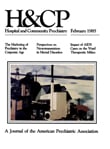Patterns of Staff Perception of Difficult Patients in a Long-Term Psychiatric Hospital
Abstract
In a study to determine which psychiatric patients are perceived by staff as most difficult to treat, clinical staff from several disciplines rated problem behaviors of 127 long-term inpatients in a private psychiatric hospital; staff also rated overall treatment difficulty, progress, and prognosis. No single patient characteristic determined staff's perception of patients as difficult to treat. Instead, four clusters of patient characteristics contributed to this perception; in decreasing order of influence, they are withdrawn psychoticism, severe character pathology, suicidal-depressed behavior, and violence-agitation. The study also showed that the patients who are considered particularly difficult are perceived as improving less and as having a poor prognosis.
Access content
To read the fulltext, please use one of the options below to sign in or purchase access.- Personal login
- Institutional Login
- Sign in via OpenAthens
- Register for access
-
Please login/register if you wish to pair your device and check access availability.
Not a subscriber?
PsychiatryOnline subscription options offer access to the DSM-5 library, books, journals, CME, and patient resources. This all-in-one virtual library provides psychiatrists and mental health professionals with key resources for diagnosis, treatment, research, and professional development.
Need more help? PsychiatryOnline Customer Service may be reached by emailing [email protected] or by calling 800-368-5777 (in the U.S.) or 703-907-7322 (outside the U.S.).



